
The Rutaceae is a family, commonly known as the rue or citrus family, of flowering plants, usually placed in the order Sapindales.

Melicope is a genus of about 240 species of shrubs and trees in the family Rutaceae, occurring from the Hawaiian Islands across the Pacific Ocean to tropical Asia, Australia and New Zealand. Plants in the genus Melicope have simple or trifoliate leaves arranged in opposite pairs, flowers arranged in panicles, with four sepals, four petals and four or eight stamens and fruit composed of up to four follicles.

Zanthoxylum is a genus of about 250 species of deciduous and evergreen trees, shrubs and climbers in the family Rutaceae that are native to warm temperate and subtropical areas worldwide. It is the type genus of the tribe Zanthoxyleae in the subfamily Rutoideae. Several of the species have yellow heartwood, to which their generic name alludes. Several species are cultivated for their use as spices, notably including Sichuan pepper.

Ochnaceae is a family of flowering plants in the order Malpighiales. In the APG III system of classification of flowering plants, Ochnaceae is defined broadly, to include about 550 species, and encompasses what some taxonomists have treated as the separate families Medusagynaceae and Quiinaceae. In a phylogenetic study that was published in 2014, Ochnaceae was recognized in the broad sense, but two works published after APG III have accepted the small families Medusagynaceae and Quiinaceae. These have not been accepted by APG IV (2016).
Neoscortechinia is a plant genus of the family Euphorbiaceae first described as a genus in 1897. It is native to Southeast Asia and Papuasia.
- Neoscortechinia angustifolia(Airy Shaw) Welzen - Sabah, Kalimantan
- Neoscortechinia forbesii(Hook.f.) S.Moore - New Guinea, Admiralty Islands, Bismarck Archipelago, Solomon Islands
- Neoscortechinia kingii(Hook.f.) Pax & K.Hoffm. - W Malaysia, Sumatra, Borneo
- Neoscortechinia nicobarica(Hook.f.) Pax & K.Hoffm. - Nicobar Islands, Myanmar, Malaysia, Indonesia, Philippines, W New Guinea
- Neoscortechinia philippinensis(Merr.) Welzen - Myanmar, Thailand, Malaysia, W Indonesia, Philippines
- Neoscortechinia sumatrensisS.Moore - W Malaysia, N. Sumatra, Simeuluë, Borneo

Baloghia is a genus of plants under the family Euphorbiaceae first described as a genus in 1833. It is native to Australia, New Caledonia, and Vanuatu. Cocconerion is a close relative.

Xylomelum is a genus of six species of flowering plants, often commonly known as woody pears, in the family Proteaceae and are endemic to Australia. Plants in this genus are tall shrubs or small trees with leaves arranged in opposite pairs, relatively small flowers arranged in spike-like groups, and the fruit a woody, more or less pear-shaped follicle.

Abrophyllum is a monotypic genus of flowering plants in the family Saxifragaceae sensu lato according to Engler, A. in Engler & Prantl and Schulze-Menz, G. K. in Melchior, 1964; placed in Subfamily Escallonioideae, Tribe Cuttsieae, it is closely related to Cuttsia. In the APG II system Abrophyllum is placed in family Rousseaceae.

Pandorea is a genus of nine species of flowering plants in the family Bignoniaceae and is native to Australia, Malesia, New Guinea and New Caledonia. Plants in the genus Pandorea are mostly woody climbers with imparipinnate leaves arranged in opposite pairs, flowers in groups with tube-shaped flowers, and winged seeds.
One of the prime systems of plant taxonomy, the Engler system was devised by Adolf Engler (1844–1930), and is featured in two major taxonomic texts he authored or co-authored. His influence is reflected in the use of the terms "Engler School" and "Engler Era". Engler's starting point was that of Eichler who had been the first to use phylogenetic principles, although Engler himself did not think that he was.

Sympetally is a flower characteristic that historically was used to classify a grouping of plants termed Sympetalae, but this term has been abandoned in newer molecular based classifications, although the grouping has similarity to the modern term asterids.

Karl Anton Eugen Prantl, also known as Carl Anton Eugen Prantl, was a German botanist.

Medicosma is a genus of shrubs and trees in the family Rutaceae, all native to New Guinea, Australia or New Caledonia. They usually have simple leaves arranged in opposite pairs, flowers arranged in cymes with four sepals, four petals and eight stamens. The fruit is a follicle fused at the base in groups of up to four, each containing one or two brown or black seeds.
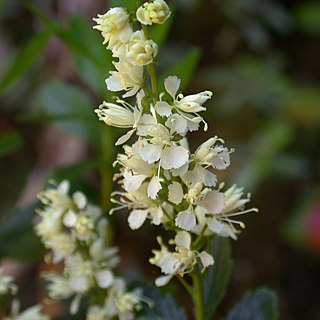
Tetracarpaea is the only genus in the flowering plant family Tetracarpaeaceae. Some taxonomists place it in the family Haloragaceae sensu lato, expanding that family from its traditional circumscription to include Penthorum and Tetracarpaea, and sometimes Aphanopetalum as well.

Sarcomelicope simplicifolia, commonly known as bauerella, hard aspen or yellow-wood, is a species of flowering plant in the family Rutaceae and is endemic to eastern Australia including Lord Howe and Norfolk Islands. It is a shrub or small tree with elliptic to egg-shaped leaves arranged in opposite pairs, male or female flowers arranged in small groups in leaf axils and fruit an oval to spherical drupe.
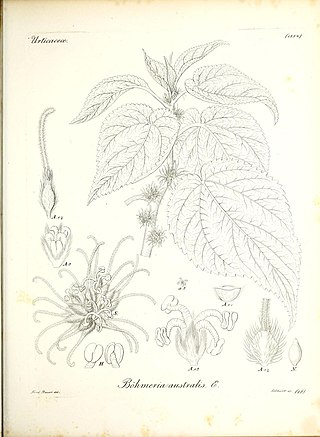
Pouzolzia australis, synonyms including Boehmeria australis and Boehmeria calophleba, is a species of large shrub or small tree in the plant family Urticaceae. It is endemic to small islands belonging to Australia and New Zealand – Norfolk Island, Lord Howe Island, and the Kermadec Islands. The population on Norfolk island, sometimes treated as a distinct subspecies, is critically endangered. In the Kermadec Islands, it was described in 2018 as "threatened – nationally endangered".
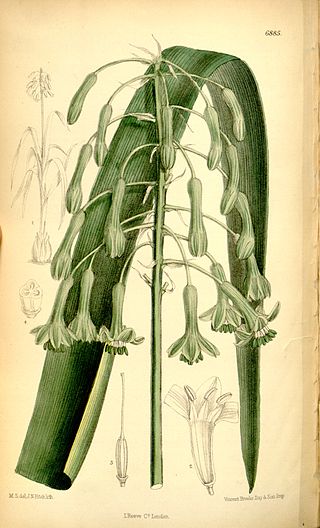
Pseudogaltonia is a genus of bulbous flowering plants in the family Asparagaceae, subfamily Scilloideae. It is distributed in southern Africa.
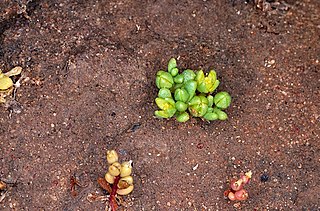
Gunniopsis septifraga, commonly known as green pigface, is a species of flowering plant in the iceplant family, Aizoaceae and is endemic to Australia. It is a prostrate to tuft-forming annual herb, with oblong to lance-shaped leaves and small greenish flowers, that grows around salt lakes.
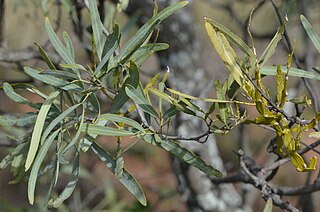
Korthalsella rubra is a flowering plant in the Santalaceae (sandalwood) family, formerly placed in the Viscaceae.

Hypericum russeggeri is a species of flowering plant in the St John's wort family Hypericaceae. The plant is a small shrub with many branches that spread across the ground, and it has many small flowers with pale yellow petals. It is found only among calcareous rocks along the coast and in the foothills of the Nur Mountains of eastern Turkey and northern Syria. While H. russeggeri has an array of phytochemicals present in its flowering structures and leaves, these are found in lower concentrations than other species of Hypericum. The species was first described in 1842 as Triadenia russeggeri, and it has been placed into various defunct genera including Elodea and Adenotrias. It is now known as Hypericum russeggeri and is the type species of Hypericum section Adenotrias, a small section that also includes H. aegypticum and H. aciferum.

















